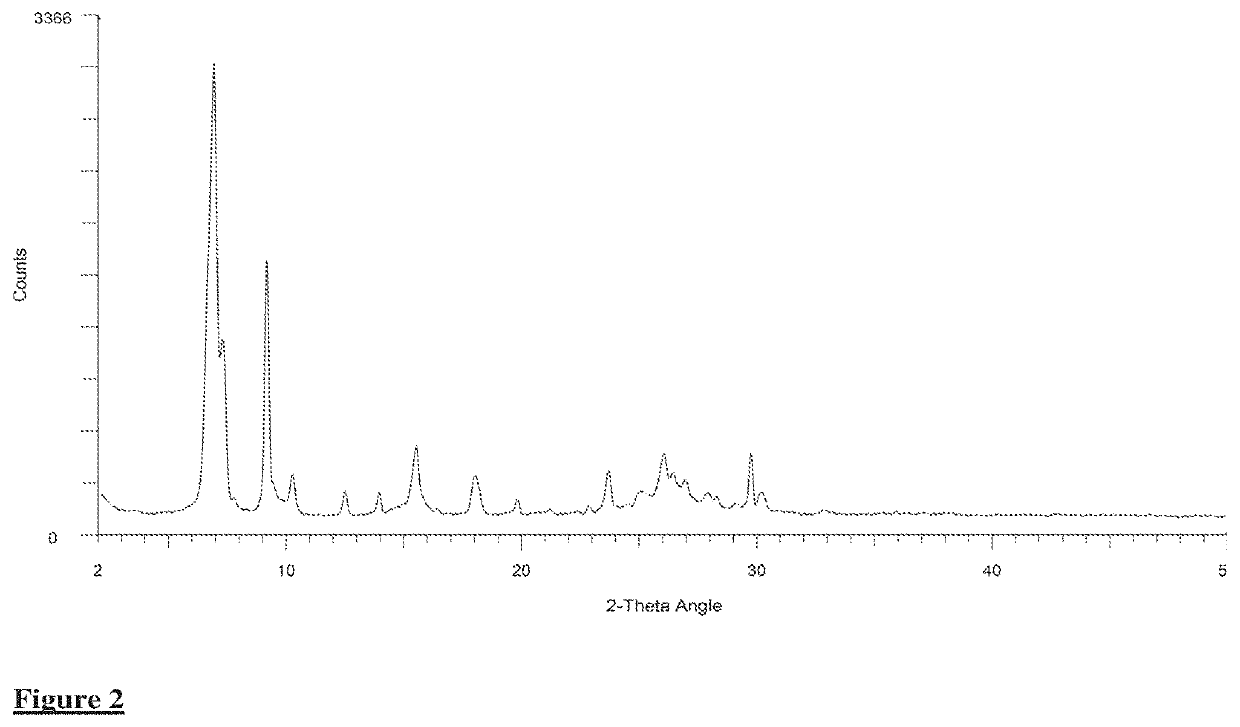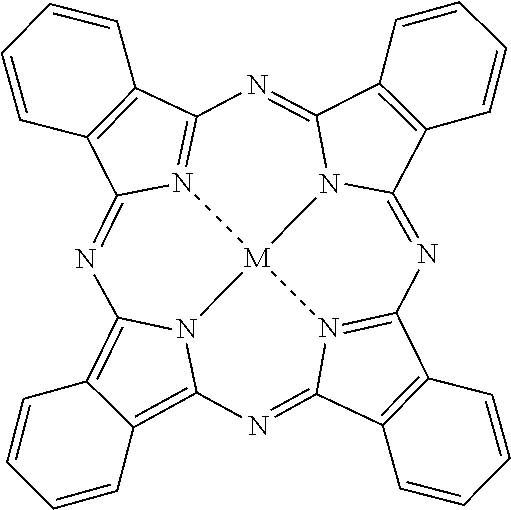Chlorinated copper phthalocyanine pigments
a technology of chlorinated copper and phthalocyanine, which is applied in the field of chlorinated copper phthalocyanine pigments, can solve the problems of not revealing the use of copper chloride in a process, affecting the effluent quality of the process, and high cost of the process
- Summary
- Abstract
- Description
- Claims
- Application Information
AI Technical Summary
Benefits of technology
Problems solved by technology
Method used
Image
Examples
example 1
Preparation of Chlorinated Copper Phthalocyanine (m=0.71; n=0.29)
[0035]In a 1-L resin flask, 92.8 g of phthalic anhydride, 27.2 g of 3-chlorophthalic anhydride, 11.0 g of 4-chlorophthalic anhydride, 163.5 g of urea, 20.7 g of copper(I) chloride, 0.5 g of ammonium dimolybdate, and 705 g of dichlorotoluene were heated to 200° C. with agitation. The reaction was allowed to stir for 2 hr. at 200° C. After this time, the contents were cooled to room temperature and the solvent was removed in vacuo. The crude residue was allowed to stir in 2500 g of water and 100 g of concentrated sulfuric acid for 2 hr. at 90° C. The crude presscake was isolated by filtration, washed to conductivity less than 100 μm hos / cm, dried, and then homogenized in an Osterizer mixer. The obtained blue crude (Crude #1) was verified by X-ray analysis (Table 1, FIG. 1). Crude #1 (27 g) was then attritted with salt (216 g) and propylene glycol (53 g) in a laboratory kneader at 80° C. for 6 hr. At the completion of the...
example 2
Preparation of Chlorinated Copper Phthalocyanine (m=0.60; n=0.40)
[0037]In a 1-L resin flask, 92.8 g of phthalic anhydride, 22.6 g of 3-chlorophthalic anhydride, 15.5 g of 4-chlorophthalic anhydride, 163.5 g of urea, 20.7 g of copper(I) chloride, 0.5 g of ammonium dimolybdate, and 705 g of dichlorotoluene were heated to 200° C. with agitation. The reaction was allowed to stir for 2 hr. at 200° C. After this time, the reaction mixture cooled to room temperature and the solvent was removed in vacuo. The residue was allowed to stir in 2800 g of water and 100 g of concentrated sulfuric acid for 2 hr. at 90° C. The pigment was isolated by filtration, washed to conductivity less than 100 μm hos / cm, dried, and then homogenized in an Osterizer mixer. The obtained blue crude (Crude #2) was verified by X-ray analysis (Table 2, FIG. 2). Crude #2. (37.5 g) was ball milled in a stainless steel jar for 6 hr. at ambient temperature. The jar contained ˜870 g of ¼ inch balls and ˜97 g of small nails....
example 3
Preparation of Chlorinated Copper Phthalocyanine (m=0.71; n=0.29) (PMV-00156-121 / PMV-00156-125)
[0040]In a 1-L resin flask, 92.8 g of phthalic anhydride, 27.2 g of 3-chlorophthalic anhydride, 11.0 g of 4-chlorophthalic anhydride, 163.5 g of urea, 10.4 g of copper(I) chloride, 16.7 g of copper(II) sulfate, 0.5 g of ammonium dimolybdate, and 485 g of light branched alkylbenzene solvent were heated to 200° C. with agitation. The reaction was allowed to stir for 2.5-3 h at 200° C. After this time, the contents were cooled to room temperature and the solvent was removed in vacuo. The crude residue was allowed to stir in 2500 g of water and 100 g of concentrated sulfuric acid for 2 h at 90° C. The crude presscake was isolated by filtration, washed to conductivity less than 100 μm hos / cm, dried, and then homogenized in an Osterizer mixer. The obtained blue crude (Crude #3) was verified by X-ray analysis. Crude #3 (27 g) was then attritted with salt (216 and propylene glycol (52 g) in a labo...
PUM
| Property | Measurement | Unit |
|---|---|---|
| yield | aaaaa | aaaaa |
| yield | aaaaa | aaaaa |
| yield | aaaaa | aaaaa |
Abstract
Description
Claims
Application Information
 Login to View More
Login to View More - R&D Engineer
- R&D Manager
- IP Professional
- Industry Leading Data Capabilities
- Powerful AI technology
- Patent DNA Extraction
Browse by: Latest US Patents, China's latest patents, Technical Efficacy Thesaurus, Application Domain, Technology Topic, Popular Technical Reports.
© 2024 PatSnap. All rights reserved.Legal|Privacy policy|Modern Slavery Act Transparency Statement|Sitemap|About US| Contact US: help@patsnap.com










